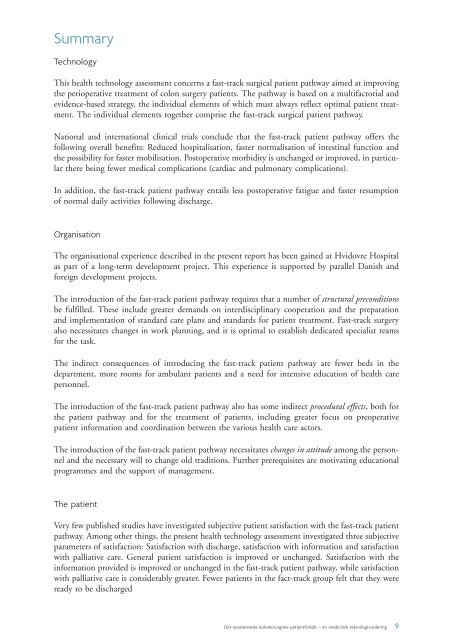Det accelererede kolonkirurgiske patientforløb - Sundhedsstyrelsen
Det accelererede kolonkirurgiske patientforløb - Sundhedsstyrelsen
Det accelererede kolonkirurgiske patientforløb - Sundhedsstyrelsen
Create successful ePaper yourself
Turn your PDF publications into a flip-book with our unique Google optimized e-Paper software.
Summary<br />
Technology<br />
This health technology assessment concerns a fast-track surgical patient pathway aimed at improving<br />
the perioperative treatment of colon surgery patients. The pathway is based on a multifactorial and<br />
evidence-based strategy, the individual elements of which must always reflect optimal patient treatment.<br />
The individual elements together comprise the fast-track surgical patient pathway.<br />
National and international clinical trials conclude that the fast-track patient pathway offers the<br />
following overall benefits: Reduced hospitalisation, faster normalisation of intestinal function and<br />
the possibility for faster mobilisation. Postoperative morbidity is unchanged or improved, in particular<br />
there being fewer medical complications (cardiac and pulmonary complications).<br />
In addition, the fast-track patient pathway entails less postoperative fatigue and faster resumption<br />
of normal daily activities following discharge.<br />
Organisation<br />
The organisational experience described in the present report has been gained at Hvidovre Hospital<br />
as part of a long-term development project. This experience is supported by parallel Danish and<br />
foreign development projects.<br />
The introduction of the fast-track patient pathway requires that a number of structural preconditions<br />
be fulfilled. These include greater demands on interdisciplinary cooperation and the preparation<br />
and implementation of standard care plans and standards for patient treatment. Fast-track surgery<br />
also necessitates changes in work planning, and it is optimal to establish dedicated specialist teams<br />
for the task.<br />
The indirect consequences of introducing the fast-track patient pathway are fewer beds in the<br />
department, more rooms for ambulant patients and a need for intensive education of health care<br />
personnel.<br />
The introduction of the fast-track patient pathway also has some indirect procedural effects, both for<br />
the patient pathway and for the treatment of patients, including greater focus on preoperative<br />
patient information and coordination between the various health care actors.<br />
The introduction of the fast-track patient pathway necessitates changes in attitude among the personnel<br />
and the necessary will to change old traditions. Further prerequisites are motivating educational<br />
programmes and the support of management.<br />
The patient<br />
Very few published studies have investigated subjective patient satisfaction with the fast-track patient<br />
pathway. Among other things, the present health technology assessment investigated three subjective<br />
parameters of satisfaction: Satisfaction with discharge, satisfaction with information and satisfaction<br />
with palliative care. General patient satisfaction is improved or unchanged. Satisfaction with the<br />
information provided is improved or unchanged in the fast-track patient pathway, while satisfaction<br />
with palliative care is considerably greater. Fewer patients in the fact-track group felt that they were<br />
ready to be discharged<br />
<strong>Det</strong> <strong>accelererede</strong> <strong>kolonkirurgiske</strong> <strong>patientforløb</strong> – en medicinsk teknologivurdering 9

















